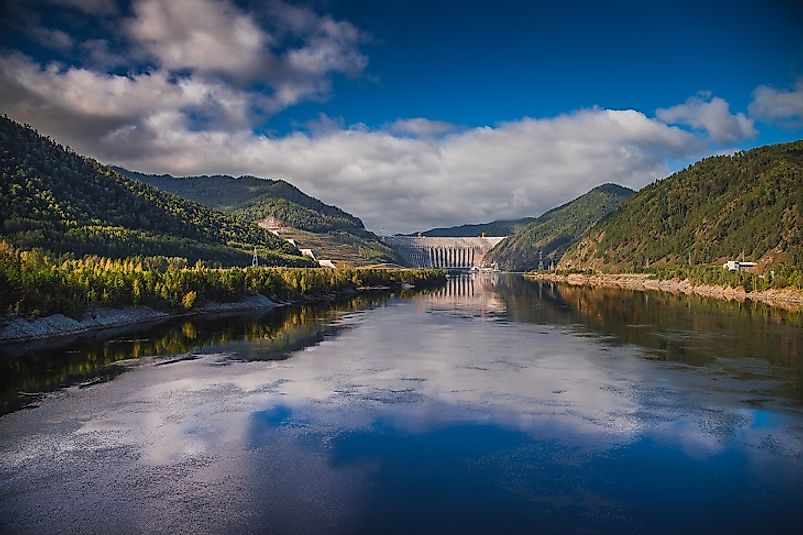The Yenisei River

5. Description
The Yenisei River rises in Mongolia and flows northwards where it drains a large area in Siberia before finally flowing out into the Kara Sea in the Arctic Ocean via the Yenisei Gulf. The Yenisei arises near the Kryzyl city of Russia at the confluence of its headstreams By-Khem (rising in the Eastern Sayan Mountains) and Ka-Khem (rising in Mongolia), and flows for a distance of 3,487 kilometers from this point until its ultimate drainage into the Kara Sea. The Angara River, which drains the Lake Baikal, is one of the major headwater tributaries of the Yenisei, and one which, after leaving Lake Baikal, joins the Yenisei near Strelka in Russia. The Yenisei River has an average depth of 45 feet, and a drainage area of around 2,580,000 square kilometers.
4. Historical Role
Prior to the arrival of the Russians, the ancient nomadic tribes of the Yugh and Ket peoples inhabited the Yenisei River region. There was probably some trade of goods between the natives of the region and Novgorod merchants in the 11th Century. The first Neo-Siberian settlement was established in 1607 on the Turukhan tributary of the Yenisei. Graduall, a number of other Russian settlements, such as Irkutsk and Krasnoyarsk, grew up along the banks of the river. With the realization of the economic potential of the Yenisei River, a large number of expeditions were conducted to explore the upper, middle, and lower reaches of the river between the 18th and 20th Centuries.
3. Modern Significance
The Yenisei River is the lifeline of a large section of the Russian population. Agriculture, cattle ranching, and fishing are some of the primary occupations of the people settled along the course of the river. Mineral deposits of coal, copper, and nickel are also mined in certain areas like Norilsk around the river basin. Lumber, petroleum products, coal, grains, and construction materials are transported via the cargo ships plying on the river between the river ports along the course of Yenisei and the Arctic seas. A large number of hydroelectric power stations, generating a total of 25 million KW, have been built on different sections of the river and its tributaries. The Sayano (pictured at the top of the article) and Krasnoyarsk are two of the largest power stations to have been built upon the Yenisei itself.
2. Habitat
The Yenisei River hosts around 55 native fish species in its waters. Siberian sturgeons, Arctic flounders, Common roaches, Northern pikes, Siberian gudgeons, tenches, and Sterlet sturgeons are some of the most notable of the native fish species in the Yenisei. A large part of the Yenisei River Basin is covered with taiga flora, largely comprised by such coniferous trees as firs, cedars, spruces, and larches. Some areas of the upper Yenisei River Basin also support steppe grasslands. Towards the north, the tagia forests are replaced by Arctic tundra vegetation, itself characterized by ice and snow cover in the cold season, and marshy plains in the summers which are covered by mosses, lichens, and other cold-tolerant plants. The Siberian musk deer, moose, roe deer, and the large Japanese field mouse are some of the mammalian species living in the taiga forests along the Yenisei. Birds like Siberian blue robins, Pallas’s rose-finches, Black-billed caper-caillies, and Swinhoe’s snipes are also found in these forests. Migrant avian species like waterfowl, ducks, geese, and swans can be spotted in the lower reaches of the river in the summertime.
1. Threats and Disputes
There are reports of Yenisei River contamination by way of radioactive discharges into the waters of the river by a factory in Zheleznogorsk which produces nuclear bomb-grade Plutonium. Radioactive nuclides like Plutonium-239 and Strontium-90 have been detected in the food chain of the river ecosystem as a result, and this occurs even hundreds of miles downstream in the river bed. Populations dependent on the Yenisei for their supply of fish and drinking water are thus subject to the damaging effects of radioactive poisoning, which could giver rise to cancers and other health problems in the future. Besides radioactivity, pollution in the form of industrial wastes and sewage, as well as fertilizer and pesticide run-offs from agricultural fields, also pollute the Yenisei along its course.











